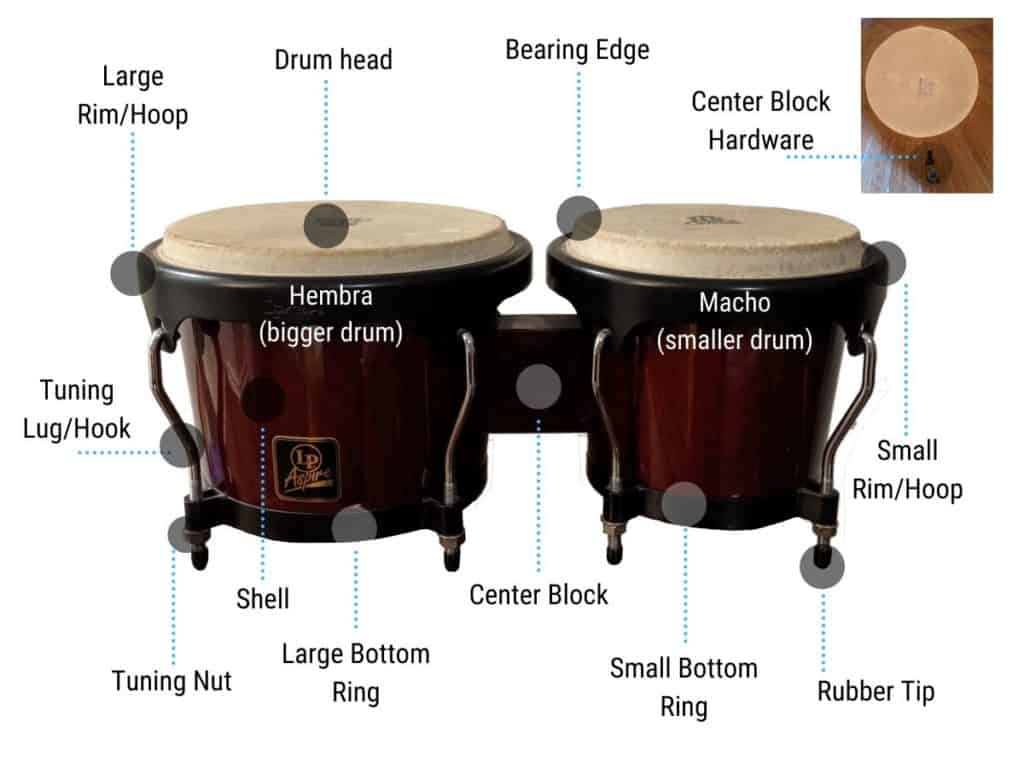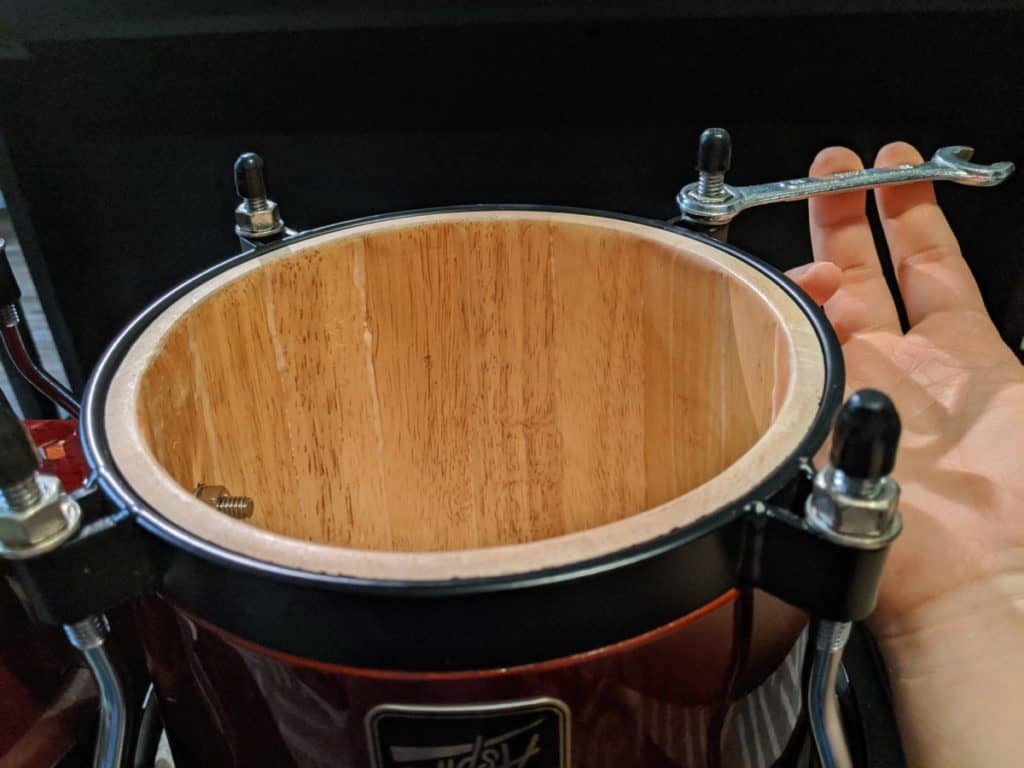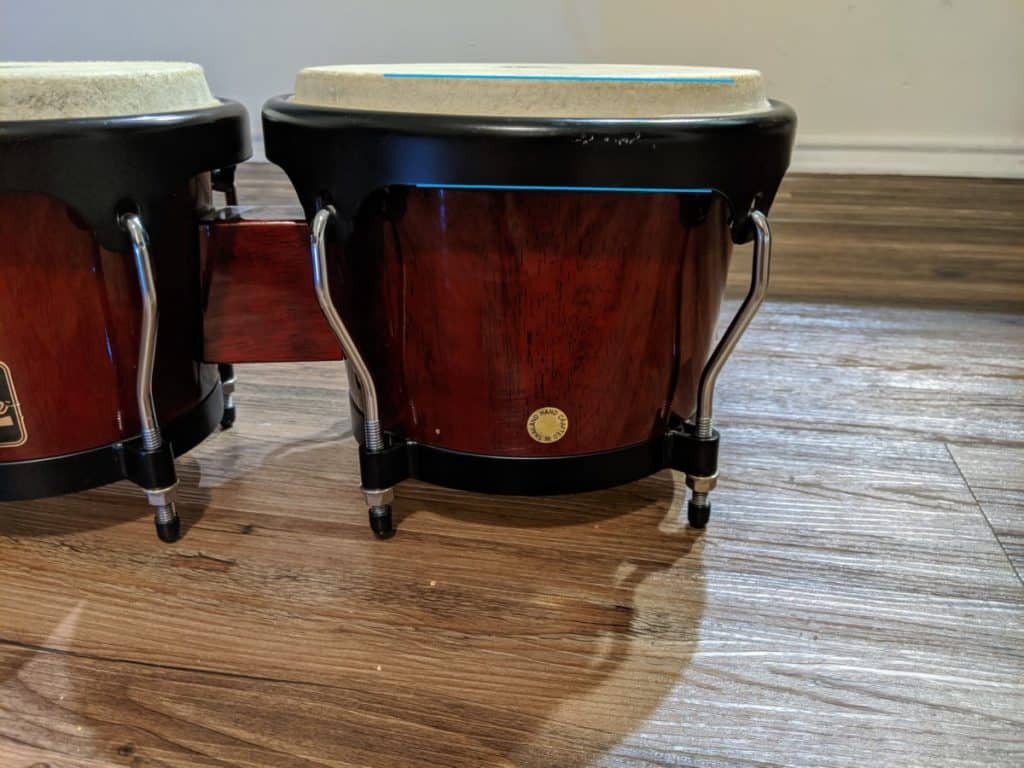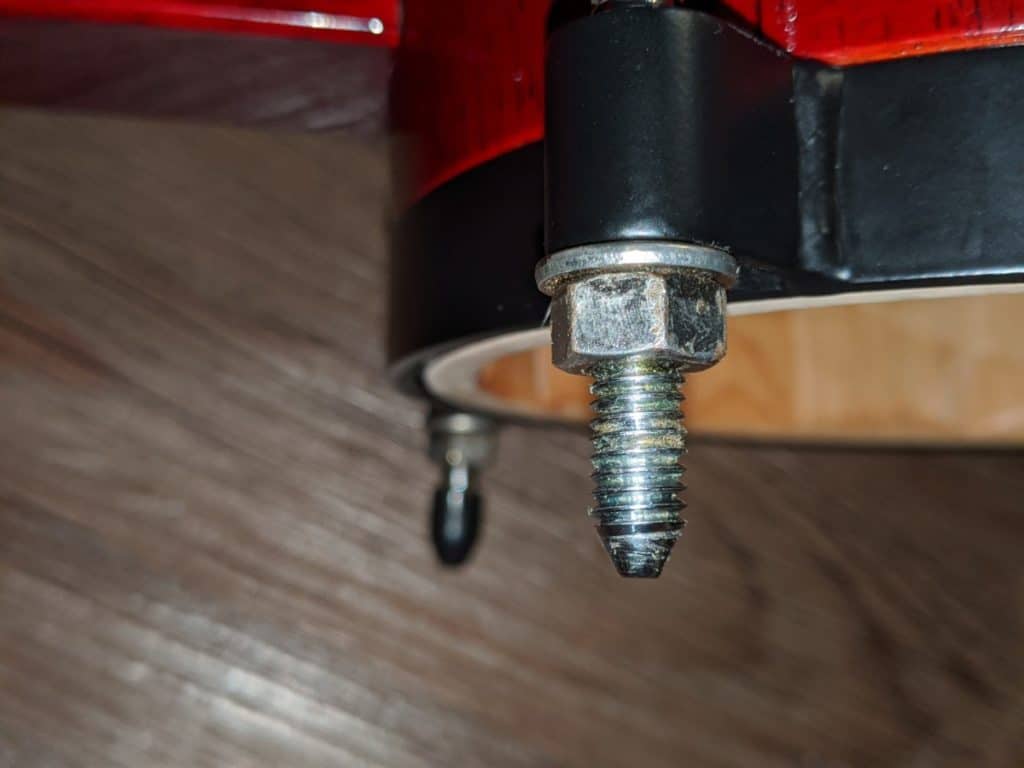How Tight Should Bongo Skins Be
This postal service contains affiliate links. We earn commissions if you purchase products from retailers later on clicking on a link from our site. As an Amazon Associate, we earn from qualifying purchases.
Believe information technology or not, at that place'south a lot to know well-nigh tuning bongos. Ultimately tuning is a personal option and the pitches that y'all cull to tighten your drumheads are up to yous. Still, everyone will cheers if yous melody your bongos properly.
Tuning your bongos properly requires tightening the tuning lugs evenly, finding the ideal pitch and resonance for the high drum (manlike), determining the proper interval between the loftier and low drum, and lastly, tuning technique.
Allow'southward get to it! I'll attempt and break this up into all the sections that you need to know and attempt to make it easy to jump to what yous're looking for.
Lightning Quick Bongo Terminology
Before we starting time, I'one thousand going to be using a lot of bongo-specific terminology, and and then it's helpful to know exactly what parts are chosen which:

By the way, looking for recording equipment? Cheque out MusiciansFriend.com for microphones, monitors, audio interface or any other recording gear that you could always demand. (Affiliate Link)
We'll be talking about those tuning lugs and the tuning nuts, the rim, and the drumhead.
Footstep-By-Step Guide to Tuning Your Bongo Drums
Now that nosotros've talked all about tuning and what notes to melody your bongos to, permit's put it all together.

- Discover the pitch that you want. Whistle it or put on a digital pitchpipe to help give y'all a reference to your target. You lot tin also utilize a pulsate tuning app (read on for more details)
- Flip the Bongos on your lap
- Get your tuning wrench ready and go around 1 drum the same amount for each tuning lug
- Y'all can use the criss-cantankerous design or you can endeavour tightening two lugs diagonal to each other at once (see below for details)
- In one case you feel a decent amount of resistance (or the drumhead starts to crepitate or crack), tighten the tuning lugs a 1/4 turn at a time.
- Periodically flip the bongos over and examine the bongos to make sure you are applying fifty-fifty pressure level beyond the drum. Strike the pulsate to check the tuning.
- You lot can cheque evenness also by striking the drum directly over the tuning lugs all around the pulsate
- Echo this procedure for the other drum
- Make any fine-tuning adjustments until yous attain your target pitch.
- Once you lot are done playing, detuning the pulsate is a common exercise. This can extend the life of your drumhead. (read more almost information technology below)
I go over tuning briefly in my video on the discipline here as well:
Bongo Basics For Beginners
What Notes To Tune Bongos To?
When y'all're tuning a trumpet or a viola you adjust the pitch to a reference note--with many drums you do the same. It's simply logical to wonder, what notes should you melody the bongos to?
It'southward non that simple, since bongo drums accept a complex sound (timbre) and information technology tin can exist difficult to be tuned to an exact pitch, however, I've been bothered that in that location are then many opinions out at that place on the internet, without much data. I sought to set up the trouble by listening to several songs and bongo soloists to go a more verbal target pitch for you.
You can see my findings in the table, below.
Finding Your Target Sound
Earlier I give you the data, I recollect the all-time affair to do is to non worry about verbal pitches, and instead focus on what sounds skillful on your particular bongo drums. I can't recommend plenty to go listen to a bongocero (bongo player) you admire or a vocal with bongos that you similar and but endeavour and imitate the same tuning.
Ultimately, your bongos are probably so different from theirs that information technology won't sound the same, but it volition get you in the aforementioned ballpark and you lot can tweak it to what yous like from there.
Every drumhead is different (specially animal skins), so a pitch that works well on i pair of bongos may not piece of work as well on some other.
Average Pitch of Bongo Drums
I decided to listen to several professional person bongo players and figure out what pitches they tuned their bongo drums to:
| Bongocero | Hembra (larger pulsate) | Macho (smaller drum) |
| Miguel Bandera Parra | D#4 | A5 |
| Alex Acuña | F4 | G6 |
| Johnny "Nifty" Rodriguez Jr. | D5 | G6 |
| Kevin Picard | D5 | A6 |
| Unknown (Bachata Studio Vocal) | B4 | F#v |
| Unknown (Salsa vocal) | ? | F#6 |
As you can see, many bongoceros that I listened to hang out in that 6th octave effectually G6. Here's the video of Swell that I listened to as an example.
Remo + Johnny "Dandy" Rodriquez: Bongo Solo
This is an extremely common tuning--as you lot can hear, the macho is tuned very tightly with minimal ringing resonance. The hembra is four notes lower (and an octave).
If you don't know what those notes sound like you tin can use an online tool like the Online Tone Generator which can help give yous a feel or where the notation should be. Bongos aren't like violins and information technology'due south difficult to know the exact pitch merely yous tin can definitely hear the note come out in the resonance of the pulsate.
Bongo Tuning App
Some other choice for tuning your bongo drums is to use an app specifically for tuning drums.
DrumtunePro (Android) (iPhone) is 1 such app that is made for tuning drumkits. The bongo is a peculiarly high-pitched drum so some say that they have to strike the bongo multiple times to get the tone to annals--this tin can help save some time and guesswork.
Another app option is Drum Tuning Calculator aka Tunebot (Android) (iPhone)
What'south the Proper Interval Between the Macho and Hembra?
Some rules of pollex that you'll see every bit y'all research bongo tuning is to tune the drums a 5th apart, or a 4th apart, or sometimes just an octave apart.
For example, if you were to cull to tune your macho to G6, then some mutual tunings would be to tune your hembra to G5, D5, or C5.
What happens if y'all tune information technology to F#, or D#? Well, cypher, that probably would audio just fine! It again depends on yous, the mode of music, the ring you're with, and the particular vocal.
If you desire some ideas, you can refer to the chart I made higher up. Not bad tuned his bongos about a 4th apart (and an octave), while Alex Acuña (another famous percussionist) tunes his bongos almost simply an octave apart.
Tuning Technique
At present, when we get down to it, there are actually means to melody that tin be dangerous for your bongo drums. I'll get to some specifics here in a scrap, but only know that these techniques can not just improve your audio, but save your drumheads from damage.
How Much of a Plough Should I Do While Tuning?
The closer you lot are to your target pitch, the less you lot should tighten the tuning lugs.
If yous are attaching new drumheads to your bongos (such as the pre-mounted variety), you should mitt tighten all lug nuts as far as you tin, and you tin do full turns (360 degrees) effectually the bongos until the drumhead starts to creak or crack (when the high pressure kicks in).
After that, cautiously increase your tuning and go a ane/iv plough at a time around each lug nut.
Once you are shut and are making fine tuning adjustments, use an ane/eighth of a plough,
Will My Drumheads Pause While Tuning?
This is a completely valid business concern--when you lot're tuning, you are going to hear the drumskin crack, popular, and crepitate. It's really unnerving and you feel like you are going to bust your bongo drumheads.
Your drumheads can have more tension than yous remember--if you are buying any drums that have been shipped from their original location, the drumheads will need to be tuned as they come quite loose.
It's quite normal for the skins to crepitate and crack as they are settling on the drumheads. Go forward--you can ever tighten the drums less and less the closer you get to your tuning target.
Do I Cross-Tune? Or Do I Go Effectually the Edge in a Circle?
I take been wondering almost this question--as I've played, I've noticed that many bongoceros recommend a different tuning pattern. I did some research and plant the following methods:
Around the World Tuning Design
This seems to be more than unremarkably used for conga drums, simply several teachers advocate for tuning one lug at a fourth dimension in a circle. Pregnant, you kickoff on one tuning lug, and so you go to the side by side adjacent tuning lug until you complete the circle.
The of import thing to remember is to make certain you do the same amount of turning for each lug nut.
Criss-Cross Tuning Pattern (the Star Formation)
This is a very common tuning technique for other types of drums and for tightening the lug basics on a car tire.
The idea is to melody a item lug nut, and then motion diagonally to the lug nut across the bongo pulsate and tighten that lug nut by the same amount.
The premise behind the criss-cross design is that it attempts to tighten the drumheads evenly--as about of the pressure from tuning is felt at the opposite end of the bongo drum. Tuning from diagonal to diagonal evens out the pressure, quickly.
Double Wrench Method
The double wrench is a counter-statement to the other tuning methods and its purpose to truly maintain an even tension on the drumhead while tuning. This method is described succinctly here:
The fastest and almost accurate fashion to tune a drum, Vol. 1. Tuning Theory.
Which Tuning Blueprint Is Best?
Ultimately it doesn't thing which pattern you choose as they all lead to the aforementioned destination. However, the "Around the World Method" is likely to atomic number 82 to the highest demand of small adjustments since the rim is existence rolled around the bongo drum and it will be very difficult to get the tension exactly the same.
The criss-cantankerous method volition work just fine. i asked a community of bongo players and the about mutual method that bongo players use is the criss-cross method.
The double wrench may take some additional skill since you are using both easily to tighten the drum, now--withal if yous got better at this skill, this may be the fastest way to tune your drums evenly, with some practrice.
The Importance of Tuning Evenly
At present, one question you might have is what's the large deal almost tuning evenly? Is information technology really a trouble if my tuning lugs are uneven?
The drumhead probably won't suffer likewise much physically if there is a little unevenness betwixt each tuning lug, but at that place are a few other reasons:
- Tone, your overall pitch and tone will be affected if the drumhead is non tightened to the same tension.
- Consistency, since you volition exist hit the bongos beyond the drumhead and not in ane spot, you don't want to have an inconsistent tone every bit your hands move across the pulsate.
- Damaging the Rim, this is perhaps the most important reason: Yous can damage the rim if you constantly have inconsistencies in tuning. If your rim is bent out of shape it's going to be difficult to get your bongos to sound decent afterwards that.
A note from Nifty in an interview on tuning (from 2:ten to 2:47):
Johnny "Swell" Rodriguez interview
How to Tune Your Bongos Evenly
The easiest way to make sure yous tune your bongos evenly is to tighten each tuning lug on the bongos equal amounts. Meaning, if y'all tighten one tuning lug a quarter plow, you then tighten all the other basics by a quarter plow before proceeding with the original tuning lug.
This doesn't always work perfectly because … well, unless y'all're a perfect quarter turner, sometimes you endeavor and be even and you lot're not perfect! There'due south all sorts of factors of why the bongo drumheads are tightened inconsistently.
How Do Yous Know If the Bongos Are Tuned Unevenly?

In that location are many means to cheque:
- Await at the contour of your drums. From this view yous can usually see hands if 1 tuning lug is pulling more the others.
- You can count the threads at the end of the tuning lugs. This only should be used as a sanity check. It's likely they will exist a little off: the threads volition just be 100% fifty-fifty if the rim is fifty-fifty, the bearing border is even, and the tuning lugs are fifty-fifty (none are bent)
- An easy-to-hear way to check if at that place's an inconsistency in tuning or an inconsistency in the drumhead is to play the drumhead right above each tuning lug.

Detuning Your Bongos After Playing
It'southward hard on your bongo drums to get through the tuning process--the rims are beingness tensioned and pulled sharply towards one another. The result is that (especially in dry out climates), information technology's not a proficient idea to allow your bongos sit at that loftier tension while you're not playing them.
From my inquiry, some drummers say that if they are in a temperature and humidity-controlled environment that detuning isn't as big a deal and that they will go out them tuned particularly if they play them oftentimes. This is definitely taking a risk because simply similar whatsoever existent skin, the consistency volition change over time if it'due south constantly stretched.
The tighter y'all have you drums, the more of import information technology is to detune them after use.
In any case, if you lot aren't playing your bongo drums often, or if yous are going to be travelling with them and exposing them to the elements, make certain you detune them and then that sudden changes in temperature or humidity don't affect them.
Again, information technology'due south not a disquisitional step in a controlled environment, but it will make the drumheads last longer if they aren't cranked to such a high tension for a long period of time.
One exception to this is if you lot have constructed drumheads – the demand to detune is much lower and you can feel more comfy leaving your drumheads tuned.
How to Detune Your Bongos
Often bongoceros will simply loosen the bongo drumheads by a full plough for each tuning lug.
One rule of pollex is to detune until you reach the point that when you push the bongo drumheads you can encounter them visibly dip--that'due south a good indicator that the drumheads are much looser than what you lot typically play with and they won't exist troubled by temperature changes.
What If My Bongos Nonetheless Audio Bad Subsequently Tuning?
Whether your bongos sound practiced or bad is very subjective. I ain a pair of Aspire bongos, and I shared a video with other players and I got some feedback talking nearly how bad my bongos sounded.
Later, I listened to the recording and tried to figure out the tuning, and it turns out my tuning matched many of the bongo players , above.
Sometimes, fifty-fifty if you lot become the tuning right, the combination of bongos and drumheads you have are not going to sound amazing.
You accept a few options:
- Spend some time tweaking your tuning: Perchance your tuning matches a bongocero yous like merely your bongos don't audio expert. It's possible your drumheads are not fifty-fifty in their tuning and and then your drumheads sound mushy and not make clean. It also could exist that a different pitch volition work amend for your bongos
- Think virtually investing in new drumheads: from my experience, many bongo playing communities really value the procedure of mounting your own drumheads. Information technology's very subjective nigh whether an musical instrument sounds skillful or not, only in whatsoever example, your sound will change drastically with unlike drumheads
- Retrieve about new bongos: The drums themselves tin can brand a difference in sound. Bongo construction can affect resonance and sound shaping (check out my mail hither to learn a trivial about how bongos make sound ), although drumheads play the biggest role in how the sound is created.
What Drumheads Are the Best For Bongos?
Welllllllll, it'southward like request which color shirts are the best. In that location's non a clear answer, but I can share the "pop vote".
Correct now at that place'southward been a huge shift of use to synthetic heads, but many nevertheless tout that animal skins sound the best. Starting time I'll share some creature peel options:
ManitoPercussion.com is renown in the bongo/conga drum community for selling some of the highest quality fauna pare available. They are a bit pricy--peculiarly their pre-mounted drumheads (pre-mounted ways they are much easier to install. Tucking your own animal hide is a laborious procedure), but the price is worth it for many.
FurandHide.com sell pulsate rounds of several different types of fauna hide at wholesale prices if you desire beast hides that are less expensive.
Constructed Drumhead Options
Remo'south Fiberskyns, Nuskyns, or their Skyndeep model of drumheads are examples of a couple favorites.
Another synthetic example: Many bongoceros use x-ray film for their macho (pocket-size drum) drumhead, it has a crisp sound--although reportedly it's difficult to become these mounted.
Bongo Drum Care
We've talked a lot virtually tuning, and detuning as a way to take care of your bongos--thankfully bongos are a fairly like shooting fish in a barrel to take care of musical instrument. I've compiled a few full general care tips so you lot can have all you need to know in one place.
- Detune your bongo drumheads after playing. (run into above for more details on the subject) Make sure you lot don't detune likewise much equally this stresses the rim to go dorsum and forth between intense pressure level and no pressure at all
- Never use any pliers or a wrench that doesn't fit the tuning lugs exactly. Pliers will strip your lug basics and you will take to replace them. Commonly bongos are tightened with a 1/2 inch or thirteen mm box wrench. You can use a socket wrench too if you'd adopt.
- Don't use any harsh cleaners on your bongo shells--it's a little too easy to take off any cease and you don't desire to do that. Even putting wood polish or any other wood treatment can impairment the finish
- Use Tuning Lug oil (specially when irresolute drumheads) on the tuning lugs and then tuning the bongos stays easy--brand sure to non get that on the drumheads
- Never stack anything remotely heavy on your bongos. This will stretch out your drumheads and can touch your rim or fifty-fifty warp your bearing edge. A music book should be fine.
- If grime starts to collect on the drumhead, you tin can clean your bongo drumheads. I've really done a bit of experimentation on this subject area and have tested a couple methods for cleaning your bongo drums. It's a fragile process which you lot can learn more about hither.
Source: https://soundadventurer.com/how-to-tune-bongo-drums/
Posted by: hulseyaginsons.blogspot.com

0 Response to "How Tight Should Bongo Skins Be"
Post a Comment